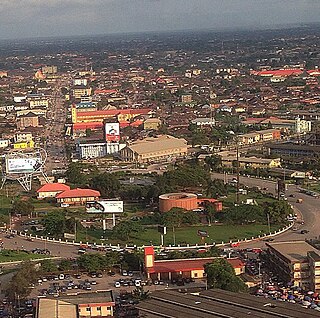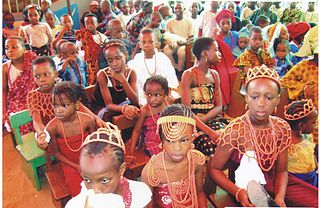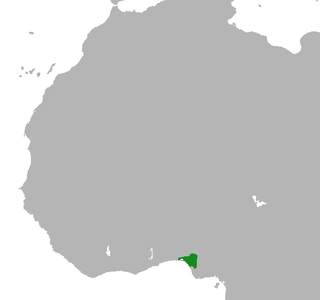
Oduduwa was a Yoruba divine king, legendary founder of the Ife Empire and a creator deity (orisha) in the Yoruba religion. His earthly origins are from the village of Oke Ora According to tradition, he was the holder of the title of the Olofin of Ile-Ife, the Yoruba holy city. He ruled briefly in Ife, and also served as the progenitor of a number of independent royal dynasties in Yorubaland.

Benin City serves as the capital and largest metropolitan centre of Edo State, situated in southern Nigeria. Notably, it ranks as the fourth-most populous city in Nigeria, according to the 2006 national census, preceded only by Lagos, Kano, and Ibadan.

Ọ̀rànmíyàn, also known as Ọranyan, was a legendary Yoruba king from the kingdom of Ile-Ife, and the founder of the Benin Kingdom and the Oyo Empire. Although he was the youngest of the descendants of Oduduwa, he became the prime heir of Oduduwa upon his return to claim his grandfather's throne.
Oba is a pre-nominal honorific for kings in Yorubaland, a region which is in the modern republics of Benin, Nigeria and Togo. Examples of Yoruba bearers include Oba Ogunwusi of Ile-Ife, Oba Aladelusi of Akure, and Oba Akiolu of Lagos. An example of a Bini bearer is Oba Ewuare II of Benin.

The Edopeople, also referred to as the Beninpeople, are an Edoid-speaking ethnic group. They are prominently native to seven southern local government areas of Edo State, Nigeria. They are speakers of the Edo language and are closely related to other Edoid ethnic groups, such as the Esan, the Etsakọ, the Isoko and Urhobo as well as other southern ethnic groups

The Kingdom of Benin, also known as Great Benin or Benin Kingdom is a kingdom within what is now considered southern Nigeria. It has no historical relation to the modern republic of Benin, which was known as Dahomey from the 17th century until 1975. The Kingdom of Benin's capital was Edo, now known as Benin City in Edo State, Nigeria. The Benin Kingdom was one of the oldest and most developed states in the coastal hinterland of West Africa. It grew out of the previous Edo Kingdom of Igodomigodo around the 11th century AD; it was annexed by the British Empire in 1897.
Ado-Odo is the metropolitan headquarters of the ancient kingdom of Ado, renowned for its Oduduwa/Obatala temple, the ancient fortress of the traditional practice of Ifá. Oodu'a is also regarded by traditionalists as the mother of all other deities. All of these made Ado an inviolate territory in western Yorubaland—the same "father-figure" status accorded to Ile-Ife. Unlike the other kingdoms, which had at one time or the other engaged in the internecine wars that ravaged Yorubaland in the nineteenth century, Ado stood out as an unconquered sanctuary city-state throughout the period.
Igodomigodo is the original name of the Benin Kingdom used by its own inhabitants.
Unuamen also spelt Unuame is an ancient village community by Ovia river in Ovia North-East Local Government Area of Edo State, Nigeria. Unuame is about 15 kilometres (9 mi) from Benin City and 20 kilometres (12 mi) from Benin Airport. Unuame is one of the ancestral homes of Oba Esigie's maternal grandfather and home town to some group of Binis. The people of Unuame have remained loyal to the monarch since the establishment of the ancient Kingdom of Benin. Being a part of the Kingdom of Benin, Unuame is at the heart of the tropical rainforest in the southern part of Nigeria, way to the west of the delta of the Niger River and inland from the coast.

The Ada and Abere are state swords of authority in Yorubaland. State swords have been used for centuries to represent the ancient rights bestowed from Ife to various Yoruba, Yoruboid, and neighbouring groups, including the Fon, Ga, and Benin Kingdom.

Oguola was the fifth Oba of the Benin Kingdom, reigning from 1280 AD to 1295 AD. His reign was marked by achievements in fortifying the city of Benin, enhancing its defences, and contributing to the cultural and economic development of the kingdom. Born into the royal family, Oguola's ascent to the throne was prompted by the extended absence of his elder brother, Prince Obuobu, who was engaged in military campaigns. This unorthodox succession was a pragmatic decision by the kingdom's elders and advisors to ensure stability and effective leadership during a critical period.
Eweka I was the first Oba of Benin and presided over the kingdom's shift from the Ogiso Dynasty to the establishment of the Obaship. His 35-year reign had a notable impact on the political, cultural, and traditional aspects of the kingdom. Before Eweka I's rule, the Benin Kingdom faced uncertainty due to the banishment of Owodo, the last Ogiso, for misrule. Oduduwa, who was the father of Oromiyan had been exiled to Uhe (Ife), which eventually set the stage for Eweka I's ascension to power. The turning point occurred when Oduduwa sent his son, Oromiyan, to Benin as an emissary. Oromiyan's arrival was met with resistance, leading to his settlement in Usama, on the outskirts of Benin City.
Akengbuda was the thirtieth Oba of Benin who reigned from c. 1750 AD – c. 1804 AD. He was the son and successor of Eresoyen, and the father of Obanosa. He is regarded as one of the most powerful and influential obas in the history of the Kingdom of Benin, as he expanded the kingdom's territory, improved its administration, and promoted its arts and culture. He also maintained a strong trade relationship with the Europeans, especially the Portuguese and the British, and acquired firearms and other goods from them. He was known for his military prowess, his diplomatic skills, and his patronage of arts and learning.

The Akure–Benin War in 1818 was a conflict between the Benin Kingdom and the Akure Kingdom in what is now Nigeria. The origins of this conflict can be traced to the complex history of the region, with Akure being a place of ancient settlements, some dating back to the early Ife kingdom. The Akure Kingdom emerged when these communities were consolidated under the rule of Prince Omoremilekun, who descended from Oduduwa, a revered figure in Yoruba history. Historically, the relationship between Benin and Akure had been marked by peace and mutual respect due to shared cultural heritage and ancestry.
Ewedo, originally known as Prince Efabo, was the fourth Oba of the Kingdom of Benin who reigned from c. 1255 AD – c. 1280 AD. He was the only son and successor of Ehenmihen. He is credited with moving the seat of his government from Usama to the present palace site, introducing various gods and laws, and changing the name of the country from Ile or Ile-Ibinu to Ubini (Benin). He also reformed the political and administrative system of the kingdom, established a palace bureaucracy, and expanded the territory and influence of Benin.
The Battle of Ekiokpagha was a military conflict that took place in 1255 on the Plains of Ogboka, near Benin City. Its designation as a battle is a mere historical formality as there was no fighting, but Ewedo's forces killed Chief Oliha, a senior ally of Ogiamien. The battle was fought between Ewedo, the recently coronated Oba of Benin, and Ogiamien III, the head of a royal family in the Benin Empire who disputed his claim to the throne. Oba Ewedo was victorious and established his palace at the site of the battle. Ewedo recognised Ogiamien III as a chief under his kingship.

A Short History of Benin is a non-fiction book by Jacob Egharevba, first published in 1934 by the Church Mission Society Press in Lagos. The book offers a historical perspective on the Benin Empire, a pre-colonial African state now part of Nigeria. The book is an English version of the author's earlier work in Edo, Ekhere Vb' Itan Edo, which was published in 1933. The book explores the beginnings, culture, and political structure of the Benin Empire, as well as the events leading to its British invasion and Ovonramwen's exile in 1897. It also includes a chronology of the Obas (kings) of Benin from the 13th to the 20th century.
Oriagba was the twenty-third ruler of the Ogiso dynasty in the ancient Kingdom of Igodomigodo, later known as the Kingdom of Benin. He implemented reforms to the monarchy, including the establishment of the system of primogeniture for succession. Oriagba's reign involved the subjugation of the Dukedom of Udo and the strengthening of hereditary governance structures for both the monarchy and the Edion'isen, the kingmakers. His reign also included the revival of the guild system and the organisation of the first royal pilgrimage to Uhe. He was succeeded by Ogiso Odoligie.
Odoligie was the twenty-fourth Ogiso of the Kingdom of Igodomigodo who ruled from 1070 to 1085 AD. Succeeding his father Oriagba, he is known for his leadership in warfare and administrative changes. He is credited with founding the Benin army and leading campaigns aimed at unifying the kingdom and addressing uprisings. Odoligie's era marked a phase of reinforced governance and territorial expansion.
Uwa was the twenty-fifth Ogiso of the Kingdom of Igodomigodo, an early state that later became part of the Benin Empire. He was the son of Ogiso Odoligie and ruled during a period of political transformation shaped by earlier reforms. His reign saw the expansion of the Benin monarchy’s influence from the River Oroghodo in the east to the River Ohosu in the west. He ordered the expulsion of the nobleman Ovio, an event that led to migrations affecting present-day Delta and Anambra.









